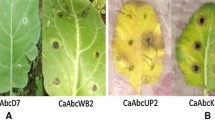Abstract
Twenty-two isolates ofVerticillium dahliae, which were isolated from green soybeean (Glycine max), udo (Aralia cordata), horseradish (Cochlearia armoracia), sweetpea (Lathyrus odoratus), or a weed (Chenopodium album) were used in this study. Conidia and microsclerotia of these isolates were morphologically identical with those ofV. dahliae but did not coincide withV. longisporum. Pathogenicity tests showed that these isolates were of weak pathotype. Eleven of the 22 isolates, which were obtained from green soybean and udo, were pathogenic to green soybeans. Thus pathotype E was composed of two groups: ‘soybean pathotype’ which was pathogenic to green soybeans; and isolates nonpathogenic to green soybeans. The latter were defined as isolates of pathotype E in the narrow sense. Selected representativenit1 and NitM mutants of eachV. dahliae isolate were paired with VCGJ testers. Fourteen isolates ofV. dahliae (So1, So22, So23, So27, So28, So39, So40, So41, U54, U68, U69, U90, U95, and U115) showed complementary reactions with subgroups J1 and J3 and were assigned to subgroup J3. Isolate U108 was assigned to subgroup J2. Isolate HR1 was not compatible with any testers of VCGJ. With this exception, isolates of pathotype E in the narrow sense and those of ‘soybean pathotype’ were thus assigned to known VCGJ subgroups and did not form a unique group corresponding to their pathotype. ‘Soybean pathotype’ could not be distinguished among isolates of pathotype E by vegetative compatibility.
Similar content being viewed by others
Literature cited
Correll, J. C., Klittich, C. J. R. and Leslie, J. F. 1987. Nitrate non-utilizing mutants ofFusarium oxysporum and their use in vegetative compatibility tests. Phytopathology77: 1640–1646.
Cove, D. J. 1976. Chlorate toxicity inAspergillus nidulan: The selection and characterization of chlorate-resistant mutants. Heredity36: 191–203.
Daayf, F., Nicole, M. and Geiger, J.-P. 1995. Differentiation ofVerticillium dahliae population on the basis of vegetative compatibility and pathogenicity on cotton. Eur. J. Plant Pathol.101: 69–79.
Glass, N. L. and Kuldau, G. A. 1992. Mating type and vegetative incompatibility in filamentous Ascomycetes. Ann. Rev. Phytopathol.30: 201–224.
Hagiwara, H. 1990. Differentiation of the pathogenicity ofVerticillium dahliae in Japan. Shokubutu-boeki44: 299–303 (In Japanese).
Hagiwara, H., Komada, H. and Kuniyasu, K. 1986.Verticillium wilt ofSenecio vulgaris naturally infected in the field. Proc. Kanto Pl. Prot. Soc.33: 142–143. (In Japanese.)
Hagiwara, H., Suwa, S., Komada, H. and Kuniyasu, K. 1987.Verticillium wilt disease ofChenopodium album L., a common upland weed, caused byVerticillium dahliae Klebahn. Proc. Kanto Pl. Prot. Soc.34: 95–97. (In Japanese.)
Horiuchi, S., Hagiwara, H. and Takeuchi, S. 1990a. Host specificity of isolates ofVerticillium dahliae towards cruciferous and solanaceous plants. In: Biological control of soil-borne plant pathogens, (ed. by Hornby, D.), pp. 285–298. CAB International, Wallingford.
Horiuchi, S., Takeuchi, S. and Tezuka, N. 1990b. Nagano isolates with different morphology and pathogenicity from pathotype D isolates ofVerticillium dahliae. Ann. Phytopathol. Soc. Japan56: 391.
Iijima, T. 1983. Studies onVerticillium wilt of tomato. Bull. Tokyo Metro. Agric. Exp. Stn.16: 63–128. (In Japanese.)
Joaquim, T. R. and Rowe, R. C. 1990. Reassessment of vegetative compatibility relationships among strains ofVerticillium dahliae using nitrate-nonutilizing mutants. Phytopathology80: 1160–1166.
Joaquim, T. R. and Rowe, R. C. 1991. Vegetative compatibility and virulence of strains ofVerticillium dahliae from soil and potato plants. Phytopathology81: 552–558.
Karapapa, V. K., Bainbridge, B. W. and Heale, J. B. 1997. Morphological and molecular characterization ofVerticillium longisporum comb. nov., pathogenic to oilseed rape. Mycol. Res.101: 1281–1294.
Kasuyama, S. and Inoue, K. 1989.Verticillium wilt of sweetpea. Ann. Phytopathol. Soc. Japan55: 98.
Koike, M., Fujita, M., Nagao, H. and Ohshima, S. 1996. Random amplified polymorphic DNA analysis of Japanese isolates ofVerticillium dahliae andV. albo-atrum. Plant Dis.80: 1224–1227.
Koike, M., Itaya, T., Hoshino, K., Nagao, H. and Ohshima, S. 1997. PCR detection of Japanese isolates ofVerticillium dahliae andV. albo-atrum using European subgroup-specific primers. Microbiol. Environ.12: 15–18.
Koike, M., Watanabe, M., Nagao, H. and Ohshima, S. 1995. Molecular analysis of Japanese isolates ofVerticillium dahliae andV. albo-atrum. Lett. Appl. Microbiol.21: 75–78.
Nagao, H., Arai, H., Ohshima, S., Koike, M. and Iijima, T. 1998. Vegetative compatibility of an isolate ofVerticillium dahliae pathogenic to both tomato and pepper. Mycoscience39: 37–42.
Nagao, H., Shiraishi, T., Ohshima, S., Koike, M. and Iijima, T. 1997. Assessment of vegetative compatibility of race-2 tomato wilt isolates ofVerticillium dahliae in Japan. Mycoscience38: 375–381.
Nagao, H., Wakatabe, D. and Iijima, T. 1994. Difficulty to establish vegetative compatibility of Japanese isolates ofVerticillium dahliae Kleb. using melanin synthesis-deficient mutants. J. Gen. Appl. Microbiol.44: 277–285.
Puhalla, J. E. 1979. Classification of isolates ofVerticillium dahliae based on heterokaryon incompatibility. Phytopathology69: 1186–1189.
Puhalla, J. E. 1985. Classification of strains ofFusarium oxysporum on the basis of vegetative compatibility. Can. J. Bot.63: 179–183.
Puhalla, J. E. and Hummel, M. 1983. Vegetative compatibility group withinVerticillium dahliae. Phytopathology73: 1305–1308.
Strausbaugh, C. A. 1993. Assessment of vegetative compatibility and virulence ofVerticillium dahliae isolates from Idaho potatoes and tester strains. Phytopathology83: 1253–1258.
Suwa, S., Hagiwara, H., Koumoto, M. and Kuniyasu, K. 1987. Pathogenicity of soybeanVerticillium wilt pathogen and its pathogenicity group. Ann. Phytopathol. Soc. Japan53: 379.
Takeda, K., Ishizaka, T. and Akanuma, R. 1988. Classification of the pathogen ofVerticillium yellows of celery by pathogenicity. Proc. Kanto Pl. Prot. Soc.35: 71–72. (In Japanese).
Wakatabe, D., Nagao, H., Arai, H., Shiraishi, T., Koike, M. and Iijima, T. 1997. Vegetative compatibility groups of Japanese isolates ofVerticillium dahliae. Mycoscience38: 17–23.
Wakatabe, D., Nagao, H. and Shiraishi, T. 1990. Occurrence ofVerticillium wilt of Touki byVerticillium dahliae. Ann. Phytopathol. Soc. Japan57: 128.
Author information
Authors and Affiliations
About this article
Cite this article
Ebihara, Y., Nagao, H., Koike, M. et al. Vegetative compatibility relationships among weakly pathogenic isolates (pathotype E) ofVerticillium dahliae . Mycoscience 40, 41–49 (1999). https://doi.org/10.1007/BF02465672
Accepted:
Issue Date:
DOI: https://doi.org/10.1007/BF02465672



